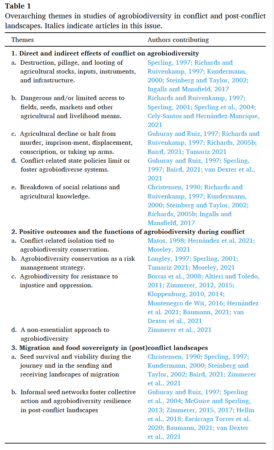- Overcoming racism in the twin spheres of conservation science and practice. Imagine.
- Getting accepted – Successful writing for scientific publication: a Research Primer for low- and middle-income countries. See above.
- A Performance Management System for Long-Term Germplasm Conservation in CGIAR Genebanks: Aiming for Quality, Efficiency and Improvement. Say what you do, do what you say, have someone verify it, correct it, improve it. Then repeat.
- Quinoa, potatoes, and llamas fueled emergent social complexity in the Lake Titicaca Basin of the Andes. Who needs maize, am I right?
- Harnessing root architecture to address global challenges. Something else for breeders to scour genebanks for.
- Evidence for host–microbiome co-evolution in apple. The genetic patterns in the endophytic microbiome of 11 wild and cultivated apple species mirrors the phylogenetic relationships among the species.
- Phylogenomic analysis points to a South American origin of Manihot and illuminates the primary gene pool of cassava. At least five wild species have contributed diversity to cassava. No word on microbiomes.
- Genetic Identification of the Local Mukodamashi Varieties of Foxtail Millet (Setaria italica (L.) P. Beauv) in Japan. Mukodamashi means “deceiving husband” and the legend is that when a wife makes dumplings from this millet variety, the husband mistakes them for rice cakes because the grains are white and sticky. Thing is though, it’s not just one variety.
Nibbles: Presentations, Taro leaf blight, Agroforestry, Agroecology, Photosynthesis
- Two guides to making good presentations. For what it’s worth, here’s my take: fewer words.
- The latest on taro leaf blight in Samoa, from an Indigenous perspective. Not a presentation in sight.
- Agroforestry in the Solomon Islands involves 132 species. Probably including taro.
- The case for agroecology from the Global Alliance for the Future of Food. You could also see the above.
- Or, we could tweak photosynthesis.
Agricultural biodiversity and conflict
The papers that compose this issue evidence how an integrative approach is not only analytically beneficial but also necessary for research supporting the sustainable resolution of conflict, the related conservation of agrobiodiversity and equitable human-environment relations.
Gabriel Tamariz and Megan Baumann have co-organized and co-edited a special issue of Geoforum on “Agrobiodiversity Change in Conflict and Post-Conflict Landscapes.” I’m hoping I won’t get into trouble for sharing this table which gives an idea of what’s in it.
Nibbles: Maize landraces, Indian plantain, Indigenous conservation, Slow Food, Design a tomato, Saffron in Vermont
- A Mexican entrepreneur and a Pawnee Keeper of the Seed try to save maize landraces in their different ways.
- Indian farmer tries to save plantain varieties.
- Indigenous conservation will save conservation.
- Alice Walters cannot save the food system. But why not let her try?
- None of the above of them would understand the concept of designing a perfect tomato.
- Saffron is the perfect spice.
Brainfood: Genetic diversity, Pointy maize, Diversification, Hybrid yeast, African yam bean, Urbanization, Wild tomato ecogeography, Wild banana seeds, Seed systems, Phytosanitary, Rematriation, Cowpea development, ABS
- The crucial role of genome-wide genetic variation in conservation. Don’t fetishise functional variation.
- The Ancient Varieties of Mountain Maize: The Inheritance of the Pointed Character and Its Effect on the Natural Drying Process. Case in point?
- Diversification for enhanced food systems resilience. Do fetishise diversification.
- Restoring fertility in yeast hybrids: Breeding and quantitative genetics of beneficial traits. Well, that’s one way to diversify. Mules next?
- Predictive genotype-phenotype relations using genetic diversity in African yam bean (Sphenostylis stenocarpa (Hochst. ex. A. Rich) Harms). From 93 IITA accessions to a handful of good ones for the fetishes of seed and/or tuber yield.
- Genetic resources management, seed production constraints and trade performance of orphan crops in Southern Africa: A case of Cowpea. Could maybe fetishise cowpea a little more?
- Urbanization and agrobiodiversity: Leveraging a key nexus for sustainable development. What’s the opposite of fetishising? Demonising? Ok, don’t demonise urbanisation then. Gosh I hope I’m using these words correctly…
- Edaphoclimatic Descriptors of Wild Tomato Species (Solanum Sect. Lycopersicon) and Closely Related Species (Solanum Sect. Juglandifolia and Sect. Lycopersicoides) in South America. We may be in danger of fetishising ecogeography.
- Banana seed genetic resources for food security: Status, constraints, and future priorities. Half of banana wild relatives are not in genebanks at all. Not that we want to fetishise crop wild relatives, but that seems a lot.
- Regulating Seeds—A Challenging Task. How do we avoid fetishising neither formal nor informal seed systems?
- The phytosanitary risks posed by seeds for sowing trade networks. The case for robust phytosanitary measures in global forage seed trade networks. No need to fetishise them though.
- The value of agrobiodiversity: an analysis of consumers preference for tomatoes. Consumers fetishise heirloom tomatoes to the tune of an additional €0.90 per kilo.
- Dynamic guardianship of potato landraces by Andean communities and the genebank of the International Potato Center. Communities don’t fetishise rematriated landraces, but that doesn’t matter.
- Facing the Harsh Reality of Access and Benefit Sharing (ABS) Legislation. The dangers of fetishising ABS. Or is it demonising?
